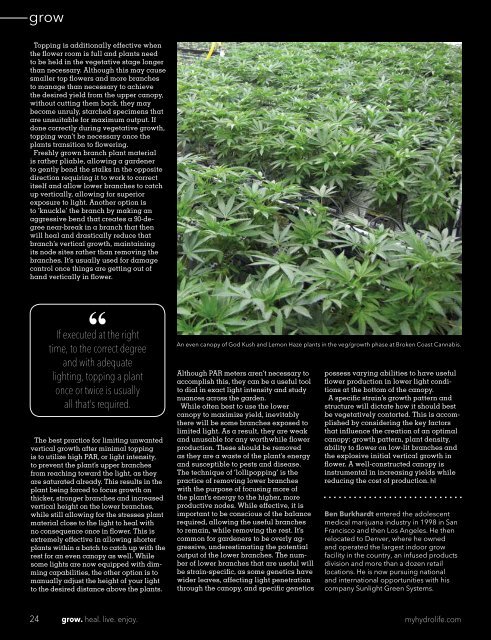Hydrolife Magazine October/November 2016 (USA Edition)
There is a lot of healing in this issue of Hydrolife. As medicinal marijuana gains acceptance in more jurisdictions, more stories are coming to the forefront revealing how cannabis healed a person where traditional drugs could not, or could but with severe side effects. We all want that miracle cure to be found where everybody is safe, where everybody is happy and where everybody is healthy.
There is a lot of healing in this issue of Hydrolife. As medicinal marijuana gains acceptance in more jurisdictions, more stories are coming to the forefront revealing how cannabis healed a person where traditional drugs could not, or could but with severe side effects. We all want that miracle cure to be found where everybody is safe, where everybody is happy and where everybody is healthy.
Create successful ePaper yourself
Turn your PDF publications into a flip-book with our unique Google optimized e-Paper software.
grow<br />
Topping is additionally effective when<br />
the flower room is full and plants need<br />
to be held in the vegetative stage longer<br />
than necessary. Although this may cause<br />
smaller top flowers and more branches<br />
to manage than necessary to achieve<br />
the desired yield from the upper canopy,<br />
without cutting them back, they may<br />
become unruly, starched specimens that<br />
are unsuitable for maximum output. If<br />
done correctly during vegetative growth,<br />
topping won’t be necessary once the<br />
plants transition to flowering.<br />
Freshly grown branch plant material<br />
is rather pliable, allowing a gardener<br />
to gently bend the stalks in the opposite<br />
direction requiring it to work to correct<br />
itself and allow lower branches to catch<br />
up vertically, allowing for superior<br />
exposure to light. Another option is<br />
to ‘knuckle’ the branch by making an<br />
aggressive bend that creates a 90-degree<br />
near-break in a branch that then<br />
will heal and drastically reduce that<br />
branch’s vertical growth, maintaining<br />
its node sites rather than removing the<br />
branches. It’s usually used for damage<br />
control once things are getting out of<br />
hand vertically in flower.<br />
If executed at the right<br />
time, to the correct degree<br />
and with adequate<br />
lighting, topping a plant<br />
once or twice is usually<br />
all that’s required.<br />
The best practice for limiting unwanted<br />
vertical growth after minimal topping<br />
is to utilize high PAR, or light intensity,<br />
to prevent the plant’s upper branches<br />
from reaching toward the light, as they<br />
are saturated already. This results in the<br />
plant being forced to focus growth on<br />
thicker, stronger branches and increased<br />
vertical height on the lower branches,<br />
while still allowing for the stresses plant<br />
material close to the light to heal with<br />
no consequence once in flower. This is<br />
extremely effective in allowing shorter<br />
plants within a batch to catch up with the<br />
rest for an even canopy as well. While<br />
some lights are now equipped with dimming<br />
capabilities, the other option is to<br />
manually adjust the height of your light<br />
to the desired distance above the plants.<br />
An even canopy of God Kush and Lemon Haze plants in the veg/growth phase at Broken Coast Cannabis.<br />
Although PAR meters aren’t necessary to<br />
accomplish this, they can be a useful tool<br />
to dial in exact light intensity and study<br />
nuances across the garden.<br />
While often best to use the lower<br />
canopy to maximize yield, inevitably<br />
there will be some branches exposed to<br />
limited light. As a result, they are weak<br />
and unusable for any worthwhile flower<br />
production. These should be removed<br />
as they are a waste of the plant’s energy<br />
and susceptible to pests and disease.<br />
The technique of ‘lollipopping’ is the<br />
practice of removing lower branches<br />
with the purpose of focusing more of<br />
the plant’s energy to the higher, more<br />
productive nodes. While effective, it is<br />
important to be conscious of the balance<br />
required, allowing the useful branches<br />
to remain, while removing the rest. It’s<br />
common for gardeners to be overly aggressive,<br />
underestimating the potential<br />
output of the lower branches. The number<br />
of lower branches that are useful will<br />
be strain-specific, as some genetics have<br />
wider leaves, affecting light penetration<br />
through the canopy, and specific genetics<br />
possess varying abilities to have useful<br />
flower production in lower light conditions<br />
at the bottom of the canopy.<br />
A specific strain’s growth pattern and<br />
structure will dictate how it should best<br />
be vegetatively contorted. This is accomplished<br />
by considering the key factors<br />
that influence the creation of an optimal<br />
canopy: growth pattern, plant density,<br />
ability to flower on low-lit branches and<br />
the explosive initial vertical growth in<br />
flower. A well-constructed canopy is<br />
instrumental in increasing yields while<br />
reducing the cost of production.<br />
Ben Burkhardt entered the adolescent<br />
medical marijuana industry in 1998 in San<br />
Francisco and then Los Angeles. He then<br />
relocated to Denver, where he owned<br />
and operated the largest indoor grow<br />
facility in the country, an infused products<br />
division and more than a dozen retail<br />
locations. He is now pursuing national<br />
and international opportunities with his<br />
company Sunlight Green Systems.<br />
24<br />
grow. heal. live. enjoy.<br />
myhydrolife.com




![Hydrolife Magazine December 2017/January 2018 [CANADIAN EDITION]](https://img.yumpu.com/59790088/1/190x247/hydrolife-magazine-december-2017-january-2018-canadian-edition.jpg?quality=85)
![Hydrolife Magazine December 2017/January 2018 [USA EDITION]](https://img.yumpu.com/59790042/1/190x247/hydrolife-magazine-december-2017-january-2018-usa-edition.jpg?quality=85)
![Hydrolife Magazine October/November 2017 [Canada Edition]](https://img.yumpu.com/59493562/1/190x247/hydrolife-magazine-october-november-2017-canada-edition.jpg?quality=85)
![Hydrolife Magazine October/November 2017 [USA Edition]](https://img.yumpu.com/59493548/1/190x247/hydrolife-magazine-october-november-2017-usa-edition.jpg?quality=85)
![Hydrolife Magazine August/September 2017 [USA Edition]](https://img.yumpu.com/59236656/1/190x247/hydrolife-magazine-august-september-2017-usa-edition.jpg?quality=85)








